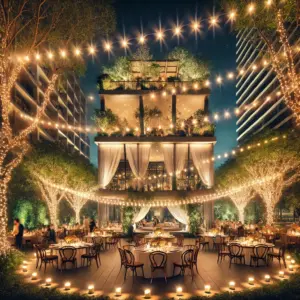Key Takeaways:
- Understanding the benefits of layered lighting for outdoor events.
- How to effectively implement a layered lighting strategy.
- Examples of successful outdoor events enhanced by layered lighting.
- Tips for selecting the right lighting solutions.
Table of Contents:
- Introduction to Layered Lighting
- Benefits of Layered Lighting in Events
- Implementing a Layered Lighting Strategy
- Examples of Successful Events
- Tips for Choosing the Right Lighting
- Potential Challenges and Solutions
- Future Trends in Outdoor Event Lighting
Introduction to Layered Lighting
Layered lighting is an innovative and sophisticated design technique that blends art and science, crucial for setting the desired mood and functionality in outdoor events. Unlike traditional lighting, which might rely solely on a single source or type, layered lighting involves the artful combination of different lighting types and intensities. This integrative approach manipulates perception, depth, and mood, making spaces visually appealing but also functional and engaging. Event planners often turn to expert outdoor lighting solutions to bring these concepts to life, relying on professionals who can tailor lighting to enhance a venue’s aesthetic and practical aspects.

Outdoor events come with unique challenges, including fluctuating weather, varying levels of natural light, and expansive, often irregular spaces that demand thoughtful lighting consideration. While indoor spaces offer a controlled environment, outdoors requires adaptive solutions that complement natural elements while ensuring the event remains a cohesive experience. Layered lighting addresses these challenges by providing flexibility and a personalized atmosphere that resonates with attendees and complements the nature of the event, whether it’s an intimate wedding, a bustling festival, or a corporate gala. Moreover, it transforms ordinary settings into immersive environments that leave lasting impressions.
Benefits of Layered Lighting in Events
Layered lighting presents many benefits beyond basic illumination; it forms the backbone of successful event design. A key feature is its ability to create distinct zones within a space, each offering a unique vibe and purpose. For example, ambient lighting can craft a relaxed backdrop for social areas, while task lighting ensures visibility in practical spaces like dining or cooking areas, enhancing both safety and functionality. Accent lighting, however, can highlight architectural features or decorative elements, providing a focal point that captivates and engages guests.
This strategic approach to lighting also promotes energy efficiency. Layered lighting systems significantly reduce energy consumption by concentrating light where it’s truly needed. Unlike overarching lighting systems that flood entire areas with light, which can be wasteful, layered lighting targets specific areas, reducing the ecological footprint. Such thoughtful design is integral to realizing an aesthetically pleasing and resource-efficient event space. Additionally, it provides peace of mind to organizers looking to balance stunning visuals with responsible consumption.
Implementing a Layered Lighting Strategy
Successfully executing a layered lighting strategy demands meticulous planning and execution. The initial step is a comprehensive assessment of the event space to identify major activities and focal areas that will benefit from distinct lighting treatments. For instance, ambient lighting establishes the overall mood for larger spaces, creating a comfortable environment for relaxed socialization. Task lighting is crucial in areas where guests engage in specific activities, such as dining tables or walkways, requiring clear visibility. Lastly, accent lighting draws attention to special features, such as stunning architecture or ornate decorations, weaving them seamlessly into the overall event narrative and enhancing the visual appeal.
An effective layered lighting plan relies on balance, allowing the seamless transition between different light layers without overpowering or conflicting with each other. Dimmer switches and smart lighting systems can vastly enhance the overall outcome, providing dynamic control over the ambiance. These technological aids allow organizers to adjust the atmosphere on the fly, seamlessly transitioning from day to night events, and adapting to changes in natural light. This flexibility ensures the setting retains its magic and impact throughout the evening. Such sophistication improves the guest experience and highlights the event as thoughtfully curated and expertly executed, marrying aesthetic allure with practical necessity in a harmonious blend.
Examples of Successful Events
Elegant Garden Wedding
A shining example of layered lighting in action was an elegant garden wedding that utilized various lighting layers to create an atmosphere of romance and intimacy. String lights were intricately suspended above, weaving through trees to create a canopy of soft ambient light. Lanterns placed strategically along pathways guided guests safely while adding an element of enchantment to their strolls. Accent lighting highlighted beautiful floral arrangements and water features, enriching the natural beauty of the surroundings. This layered approach met functional needs and encapsulated the dreamy vision of the wedding, leaving couples and guests with an indelible memory. The cohesive lighting setup ensured that every facet of the celebration was highlighted, turning a cozy garden into a romantic haven that dazzled every attendee.
Corporate Retreat
In a contrasting setting, a corporate retreat showcased the transformative power of layered lighting within a forested venue. Here, the challenge lay in creating environments conducive to professional networking and relaxed socialization. Uplighting on tall trees created a soft glow, enhancing the natural setting and providing an effective boundary around key event spaces. Task lighting brightly illuminated dining and presentation areas, ensuring all speeches and culinary displays were center stage. This strategy also utilized color-changing LED lights adapted to different retreat segments, underscoring keynote sessions with vibrant hues while allowing for softer tones in relaxation areas. The versatility of layered lighting thus turned the retreat into a multifaceted success, balancing work and leisure seamlessly. It created an engaging space that allowed professionals to network while enjoying a serene and inviting environment, highlighting the event’s dual purpose with visual finesse.
Tips for Choosing the Right Lighting
- Determine Your Focal Areas: Assess the venue to identify primary areas requiring attention. Key spaces often include entrances, main gathering areas, and scenic highlight points. The strategic illumination of these zones ensures guests are guided intuitively through the event space.
- Embrace Energy Efficiency: Opt for lighting solutions like LEDs that offer bright, consistent light with minimal energy use. Such choices decrease costs over time and align with green initiatives. They also offer longevity and durability, minimizing the need for frequent replacements.
- Consider Color Temperature: Warm lights can invoke a cozy and welcoming environment, suitable for social gatherings. Cooler temperatures energize spaces, making them ideal for more formal or active areas. Experiment with combinations to find the perfect balance for your event’s theme and goals.
- Use Smart Controls: Incorporate technologies like dimmers and smart bulbs to allow for adjustable brightness levels. These tools enhance flexibility, allowing you seamlessly adapt lighting settings for each event phase. This improves the visual experience and ensures that energy use is optimized.
- Ensure Durability: Given the outdoor setting, choose fixtures that can withstand the elements. Water-resistant and UV-protected materials are essential to maintain performance and safety regardless of weather conditions. Such considerations ensure longevity and reliability, safeguarding your lighting investment.
Potential Challenges and Solutions
Layered lighting presents opportunities for breathtaking event designs, yet it comes with its own set of challenges. Integrating different lighting elements into a coherent design requires specialized know-how and foresight. Overcoming this complexity is often achieved through collaboration with specialists in expert outdoor lighting solutions, who can provide insight and guidance that customizes lighting schemes to perfection. Their expertise helps avoid common pitfalls and ensures the lighting design complements the venue and event objectives seamlessly.
Concerns regarding sustainability are also prevalent in modern event planning, urging a shift towards eco-friendly lighting options. By incorporating energy-efficient solutions such as solar-powered lighting and recycled material fixtures, events can achieve their aesthetic and sustainability goals. Additionally, the advent of smart lighting solutions helps manage energy consumption, automatically adjusting lighting based on real-time environmental inputs, thus marrying efficiency with innovation and ensuring both visual impact and environmental responsibility. These efforts resonate with increasingly eco-conscious audiences, enhancing reputation and demonstrating a commitment to sustainable practices aligned with broader environmental goals.
Future Trends in Outdoor Event Lighting
The future of outdoor event lighting is teeming with technological advancements that promise to reshape how environments are illuminated. Smart lighting solutions offer unprecedented personalization, allowing event managers to adjust light settings remotely and in real-time, optimizing ambiance and energy use according to guest behavior and climatic shifts. This adaptability leads to more immersive and responsive event experiences, where lighting can be tailored to each unique moment.
Sustainability continues to define lighting trends, with growing attention to environmentally friendly solutions. The industry is moving towards using renewable energy-powered lighting systems, such as solar and wind, and embracing materials with minimal environmental impact. These innovations support eco-conscious event planning while delivering high-caliber visual effects. By staying apprised of these evolving trends, planners can ensure their events not only captivate through innovative lighting but also reflect a commitment to ecological stewardship, driving the future of event design towards sustainability and brilliance. Such forward-thinking initiatives are essential for staying competitive and relevant in a landscape that increasingly values sustainability as a core component of successful event planning.
Conclusion
Layered lighting is more than a design choice—it’s fundamental to creating successful, memorable outdoor events. By crafting a dynamic interplay of light and shadow, planners can elevate any event space, providing environments that captivate and enthrall. As event experiences evolve, so must lighting strategies, incorporating the latest technology and sustainability to meet rising expectations. Embracing these innovations ensures that layered lighting remains a beacon of event excellence, illuminating paths toward stunning visual craftsmanship and responsible environmental stewardship. By doing so, events stand out in brilliance and contribute positively to the environment, satisfying the dual goals of excellence and sustainability with flair.



